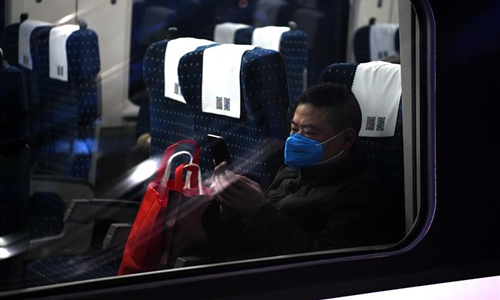HOME >> SOURCE
A snapshot into China's 'hardcore' efforts to revive the economy
By Wang Cong Source:Globaltimes.cn Published: 2020/2/19 3:58:50

A returning worker bound for East China's Zhejiang Province waits for departure on the customized train at Chengdu East Railway Station in Chengdu, southwest China's Sichuan Province, Feb. 17, 2020. The customized train for returning workers left Chengdu on Monday, carrying more than 750 workers from Sichuan who are returning to work in Hangzhou, capital of Zhejiang Province, the first such train service in Sichuan. (Xinhua/Wang Xi)
Since the deadly coronavirus broke out in China and brought the country to a near standstill, much has been said about how severe the impact of the epidemic will be on the Chinese economy and how China, because of "flaws" in its economic system, could fail to resurrect the world's second-largest economy.
Some in the US even declared that "China is the real sick man of Asia." However, the realities depict a vastly different picture from those assertions.
As the epidemic shows abating signs in many places outside Hubei, the epicenter of the outbreak, Chinese officials from the capital of Beijing to small towns have waged what they call another battle to revive the economy, rolling out policy packages one after another to support business to resume production.
There have been many media reports about the slow progress of the efforts to resume economic activities. But details of how officials are carrying out those policies remain unclear. On Tuesday, an official with the trade office of Keqiao district of Shaoxing, East China's Zhejiang Province offered a snapshot into how officials work around the clock and make what many call "bold and hardcore" efforts.
Keqiao is an internationally renowned export hub for textile products and home to more 2,000 businesses and factories that rely heavily on workers from outside Zhejiang. For labor-intensive sectors in Keqiao, the epidemic could not have been worse, as workers have been trapped at home across the country.
"The biggest problem for us is that we have no workers. No workers means no production; no production means we are going to lose our market. And that's our lifeline," the official, who spoke on the condition of anonymity, told the Global Times on Tuesday.
Keqiao, with a population of about 690,000, gets more than 65 percent of its GDP from exports, which reached 86.6 billion yuan ($12.38 billion) in 2019 - much of that came from exports of textile products to Europe and other parts of the world. The city was already under pressure from the tariff war between the US and China and relocation of some factories to countries in Southeast Asia.
So, after meetings of the Standing Committee of the Central Political Bureau of the Communist Party of China and of the State Council - China's top decision-making bodies called on places where the epidemic is not as severe, Zhejiang, Shaoxing and Keqiao officials went to work.
In Keqiao, more than 1,000 officials were dispatched door-to-door to find out what prevented businesses and factories from resuming production, make sure companies take preventive measures against the virus and help them resume production in safe conditions, according to the official.
After several meetings, decisions were made to "do whatever it takes" to bring in workers from across the country. That included sending buses to provinces to pick up workers, reimbursing travel expenses, free accommodation and cash incentives. The official said that Keqiao is open to workers from even Hubei, if they took proper protective measures and has no health issues.
“To resume production, we are trying hard to hire workers from various places and our companies have rented cars to pick up workers from out of the province,” the official said, adding that the local government also offer incentives for new workers from outside of Zhejiang.
The official said that to ensure returning workers have a hotel to stay in or a restaurant to eat at, they have even ordered some to reopen. "They told me that there is no business so they want to remain closed, but I told them, 'if you don't open then there will never be business,'" the official said.
On social media, some frustrated with the epidemic and wondering when they will return to their jobs applauded the measures as bold and that would guide the country back to normality, while others raised questions about public health risks posed by the moves. After all, the epidemic remains a serious challenge, with the number of new confirmed cases still on the rise.
But the official in Keqiao argued that the measures are well-thought out and based on weeks-long efforts to combat the outbreak to ensure their effectiveness. "We can do this now because we have worked tirelessly since the first day of the Chinese New Year to stop the virus from getting here," the official said, noting that there have been only a few confirmed cases from outside of Keqiao and no locally infected cases.
As of Monday night, Zhejiang has 1,172 confirmed cases, of which 514 have been cured and zero deaths. It reported only one new infection on Monday. Shaoxing, which has a total of 42 cases, reported no new confirmed cases on Monday.
To prevent infection when businesses resume operations, Zhejiang has launched a digital platform backed by big data to closely track returning workers and other residents. Strict protocols will also put in place at factories to protect their workers, according to the official.
"We understand the risks. But we are confident because we are prepared and if we follow the procedures, there will be no problem," the official said. However, if other parts of the country cannot resume production on time, then the whole industrial chain cannot operate and Keqiao's early resumption of work will also be affected, the official said. "It requires everyone to keep up the same steps," he said.
Posted in: ECONOMY